
Alectryon is a genus of about 30 species of trees and shrubs from the family Sapindaceae. They grow naturally across Australasia, Papuasia, Melanesia, western Polynesia, east Malesia and Southeast Asia, including across mainland Australia, especially diverse in eastern Queensland and New South Wales, the Torres Strait Islands, New Guinea, the Solomon Islands, New Caledonia, New Zealand, Vanuatu, Fiji, Samoa, Hawaii, Indonesia and the Philippines. They grow in a wide variety of natural habitats, from rainforests, gallery forests and coastal forests to arid savannas and heaths.

Harpullia is a genus of about 27 species of small to medium-sized rainforest trees from the family Sapindaceae. They have a wide distribution ranging from India eastwards through Malesia, Papuasia and Australasia to the Pacific Islands. They grow naturally usually in or on the margins of rainforests or associated vegetation.

Jagera is a genus of 4 species of forest trees known to science, constituting part of the plant family Sapindaceae.
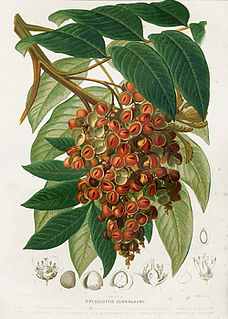
Diploglottis is a genus of 10 species of trees known to science, constituting part of the plant family Sapindaceae. They grow naturally in rainforests and margins of adjoining humid forests in eastern Australia and New Guinea. Some species are known as native tamarind or small-leaved tamarind; they have no direct relationship with the true tamarind.
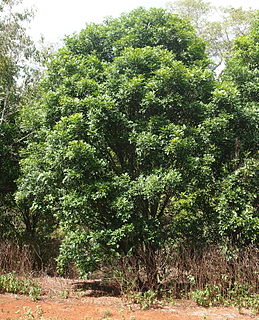
Atalaya is a genus of eighteen species of trees and shrubs of the plant family Sapindaceae. As of 2013 fourteen species grow naturally in Australia and in neighbouring New Guinea only one endemic species is known to science. Three species are known growing naturally in southern Africa, including two species endemic to South Africa and one species in South Africa, Swaziland and Mozambique.

Alectryon macrococcus, known as ʻAlaʻalahua or Māhoe in Hawaiian, is a species of flowering tree in the soapberry family, Sapindaceae, that is endemic to Hawaii.
Alectryon ramiflorus is a species of endangered small seasonal rainforest trees from the plant family Sapindaceae. They are endemic to a very restricted area of southeastern Queensland, Australia. Threats of extinction to the species include habitat loss and disturbance of a catastrophic degree from wildfire or storms.
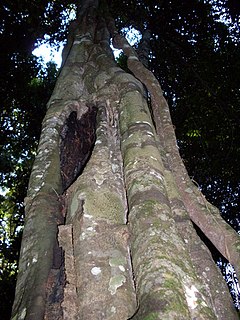
Alectryon subcinereus, commonly named native quince, wild quince or bird's eye, is a species of shrubs or small trees, constituting part of the plant family Sapindaceae.

Alectryon tomentosus, commonly known as the hairy birds eye, red jacket or woolly rambutan, is a rainforest tree of the family Sapindaceae found in eastern Australia. The specific epithet tomentosus refers to the hairy leaves and hairy young shoots.

Darwinia micropetala, commonly known as small darwinia, is a small shrub that is native to south-eastern Australia. It grows to 0.5 metres high and has small leaves and clusters of small white and pink flowers that appear between June and December in the species' native range.

Alectryon oleifolius, commonly known as the boonaree or inland rosewood, is a species of small tree of the soapberry family Sapindaceae, native to Australia.

Harpullia hillii, commonly known as blunt-leaved tulip or oblong-leaved tulip, is a tree in the family Sapindaceae, endemic to eastern Australia. Although the species may grow to 20 metres high, most trees are less than 10 metres high. Each leaf comprises 4 to 12 leaflets, that are oblong or elliptic oblong and between 5 and 15 cm long and 2 to 6 cm wide. White flowers with petals 10–12 mm long appear in panicles that are 10–25 cm long. These are followed by orange fruit that are 25–30 mm in diameter and 12–14 mm long. The fruit, which is positioned above the persistent sepals, becomes woody with age. The glossy black seeds protrude from red arils.
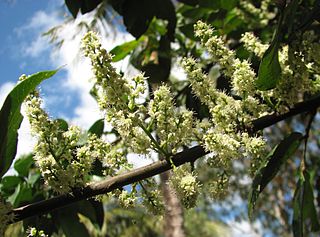
Guioa acutifolia is an evergreen tree from New Guinea and coastal areas of eastern Queensland in Australia. Common names include glossy tamarind, northern guioa and sharp-leaf guioa. It grows up to 20 metres high and has smooth, grey bark on its trunk which may be up to 15 cm wide. The sweetly scented flowers are produced between August and October in the species' native range Flowers and fruits often appear on immature trees.

Toechima daemelianum, commonly known as cape tamarind, is an evergreen tree from north-east Queensland in Australia. It grows up to 13 metres high and a trunk which may be up to 20 cm wide.
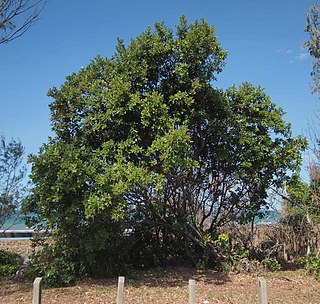
Alectryon connatus, sometimes named hairy alectryon, is a species of small trees, constituting part of the plant family Sapindaceae.

Cossinia is a genus of four species of rainforest trees, constituting part of the plant family Sapindaceae. The genus has a disjunct distribution, occurring in Mascarene Islands, Australia, New Caledonia and Fiji.
Cossinia australiana is a species of seasonal rainforest trees endemic to restricted areas of Queensland, Australia, and constituting part of the plant family Sapindaceae.
Hollandaea sayeriana, sometimes named Sayer's silky oak, is a small species of Australian rainforest trees in the plant family Proteaceae.
Sally T. Reynolds is an Australian botanist.

Harpullia alata, common name -winged tulip or wing-leaved tulip, is a tree in the family Sapindaceae, endemic to eastern Australia, and found from Brisbane, Queensland to Grafton, New South Wales.
















